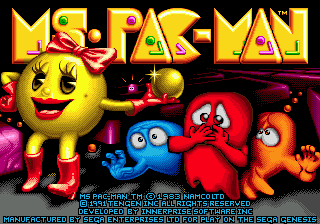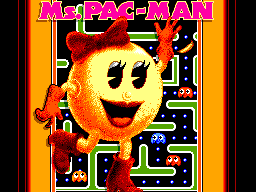This short article is in need of work. You can help Sega Retro by adding to it.
Ms. Pac-Man is a 1981 arcade game developed by Midway Manufacturing as an unlicensed modification of the original Pac-Man, before being taken by Namco as an official game. Its success caused the game to be ported to a plethora of platforms, including the Sega Mega Drive and Sega Master System in 1991 and the Sega Game Gear in 1993.
The Sega ports of Ms. Pac-Man can be confusing. Tengen originally brought the game to the Mega Drive in North America and the Master System in 1991, but four years later the game was brought to European Mega Drives by the successor to Tengen, Time Warner Interactive (although the ROM still credits Tengen). The Game Gear port was handled in-house by Namco and was released twice - initially in 1993, and then re-released by Majesco in 2000.
Gameplay
Players move through a maze gobbling up Pac-Dots while avoiding ghosts. If a big dot (Power Pellet) is eaten by the player, ghosts become edible and if eaten their eyes depart from the body and flee to the center of the maze, where they can claim a new body. Occasionally fruit and other objects float through the maze and give bonus points if eaten.
On the Mega Drive and Master System versions there are many new extras. There are four types of mazes: Arcade, Strange, Big, and Mini. A Pac Booster ability can be turned on and off, which gives the player a boost when pressing a button. There is also two-player simultaneous feature in which the first player will play Ms. Pac-Man and the second will play the original Pac-Man. This can be done in cooperative or competitive modes. The game also would end at level 32 in which a game ending would be displayed. The "fruit" selection is also expanded and objects such as shoes could be eaten for greater points than fruit in the arcade version.
This game doesn't have good compatibility with the Six Button Control Pad, in this case meaning that Ms. Pac-Man responds badly to direction changes. Hold the MODE button when booting up the system to switch to 3-button mode and fix this issue.
Production credits
Mega Drive version
- Programmer: Stephane Leblanc
- Graphics: Mike Bazzell
- Music/Sounds: Earl Vickers
- Music Player: Lisa Ching
- Thanks to: Jeff Yonan, Franz Lanzinger
Magazine articles
- Main article: Ms. Pac-Man/Magazine articles.
Promotional material
- Main article: Ms. Pac-Man/Promotional material.
Physical scans
Mega Drive version
| Mega Drive, US
|
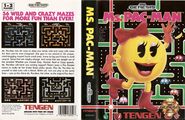 Cover
|
 Cart |
| Mega Drive, US (alt)
|
|
|
 Cart  Manual |
| Mega Drive, US (cardboard box)
|
|
|
 Cart  Manual |
| Mega Drive, EU
|
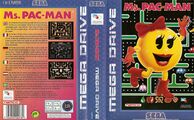 Cover
|
 Cart |
Master System version
| {{{{{icon}}}|L}}
|
Division by zero.
|
Based on
0 review
|
| Master System, EU
|
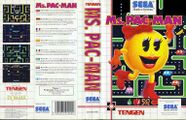 Cover
|
 Cart  Manual |
| Master System, PT
|
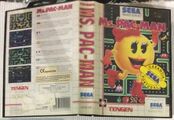 Cover
|
|
|
| Master System, AU
|
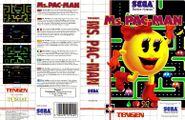 Cover
|
 Cart |
| Master System, BR
|
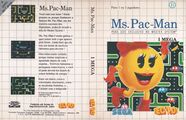 Cover
|
 Cart |
Game Gear version
|
|
Division by zero.
|
Based on
0 review
|
| Game Gear, US
|
|
|
 Cart  Manual |
Technical information
ROM dump status
| System |
Hash |
Size |
Build Date |
Source |
Comments |
|
|
|
| ✔
|
| CRC32
|
af041be6
|
| MD5
|
cfe7f3023b21bcf697bcf5e1be461ee7
|
| SHA-1
|
29fff97e19a00904846ad99baf6b9037b28df15f
|
|
128kB
|
1991-03
|
Cartridge (US/EU)
|
|
|
|
|
| ?
|
| CRC32
|
3cd816c6
|
| MD5
|
e492a237f62ea6a5b7e71ff1a3fc0f33
|
| SHA-1
|
4dd7cb303793792edd9a4c717a727f46db857dae
|
|
128kB
|
|
Cartridge (EU)
|
|
|
|
|
| ?
|
| CRC32
|
5ee88bd5
|
| MD5
|
d65e3350cba32a42d54130c356feb2a8
|
| SHA-1
|
dbba762b62e786be2c1df30a595cf3bc11b106c5
|
|
128kB
|
|
Cartridge (US)
|
|
|
|
|
References
- ↑ Electronic Gaming Monthly, "July 1991" (US; 1991-xx-xx), page 110
- ↑ GamePro, "June 1991" (US; 1991-xx-xx), page 40
- ↑ 3.0 3.1 3.2 Mean Machines Sega, "February 1996" (UK; 1995-12-xx), page 84
- ↑ 4.0 4.1 4.2 4.3 Game Zone, "December 1991" (UK; 1991-11-22), page 47
- ↑ 5.0 5.1 Sega Power, "February 1992" (UK; 1992-01-02), page 49
- ↑ Joypad, "Avril 1992" (FR; 1992-03-1x), page 84/85 (84)
- ↑ 7.0 7.1 Joystick, "Avril 1992" (FR; 1992-0x-xx), page 118
- ↑ 8.0 8.1 Player One, "Mars 1992" (FR; 1992-03-10), page 69
- ↑ 1700 igr dlya Sega, "" (RU; 2001-xx-xx), page 200
- ↑ Game Informer, "May/June 1993" (US; 1993-0x-xx), page 48
- ↑ Joypad, "Avril 1992" (FR; 1992-03-1x), page 84
- ↑ Mega Play, "July/August 1991" (US; 1991-0x-xx), page 65
- ↑ Power Play, "2/92" (DE; 1992-01-xx), page 166
- ↑ Sega Pro, "April 1993" (UK; 1993-03-11), page 66
- ↑ Tricks 16 bit, "Tricks Sega Gold 800 igr" (RU; 1998-03-20), page 124
- ↑ VideoGames & Computer Entertainment, "October 1991" (US; 1991-xx-xx), page 46
- ↑ Consoles +, "Octobre 1992" (FR; 1992-xx-xx), page 132
- ↑ Console XS, "June/July 1992" (UK; 1992-04-23), page 142
- ↑ Hobby Consolas, "Octubre 1992" (ES; 1992-xx-xx), page 122
- ↑ Joypad, "Janvier 1992" (FR; 1991-12-1x), page 49
- ↑ Joystick, "Janvier 1992" (FR; 199x-xx-xx), page 117
- ↑ Mega Force, "Mai 1992" (FR; 1992-05-05), page 65
- ↑ Micromanía (segunda época), "Noviembre 1992" (ES; 1992-1x-xx), page 79
- ↑ Mean Machines, "December 1991" (UK; 1991-11-28), page 60
- ↑ Mean Machines Sega, "October 1992" (UK; 1992-09-xx), page 135
- ↑ Player One, "Octobre 1992" (FR; 1992-10-10), page 138
- ↑ Sega Pro, "Christmas 1991" (UK; 1991-12-12), page 64
- ↑ Sega Pro, "April 1993" (UK; 1993-03-11), page 71
- ↑ Sega Force, "April 1992" (UK; 1992-03-19), page 52
- ↑ Supergame, "Outubro 1992" (BR; 1992-10-xx), page 36
- ↑ Supersonic, "Septembre 1992" (FR; 1992-xx-xx), page 21
- ↑ Video Games, "2/92" (DE; 1992-04-06), page 36
- ↑ Game Players, "Vol. 7 No. 7 July 1994" (US; 1994-0x-xx), page 68
- ↑ GamePro, "May 1994" (US; 1994-xx-xx), page 132
- ↑ Game Informer, "July/August 1994" (US; 1994-0x-xx), page 48
